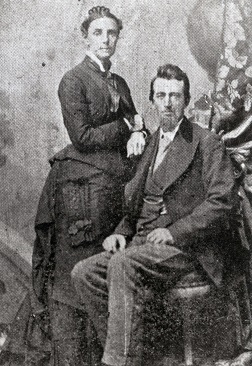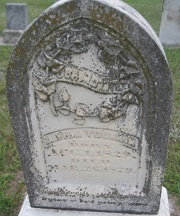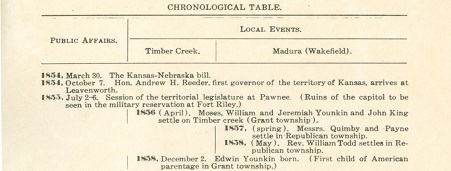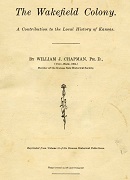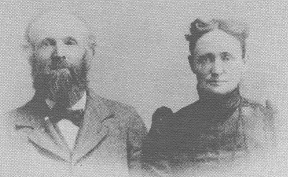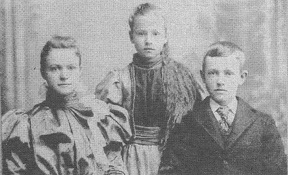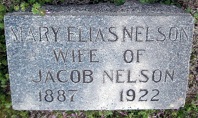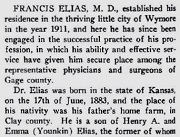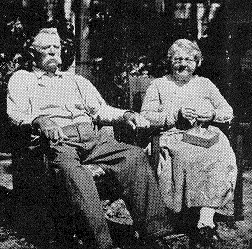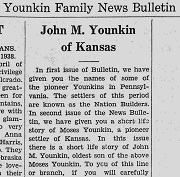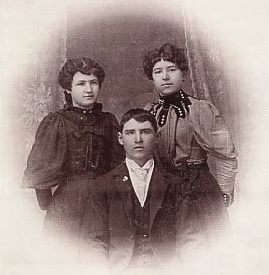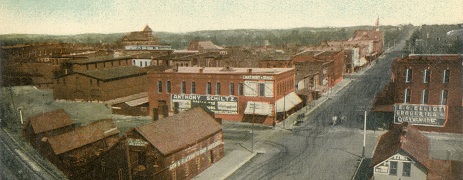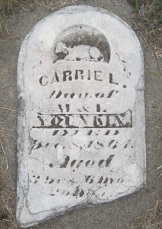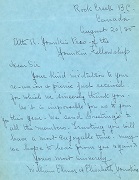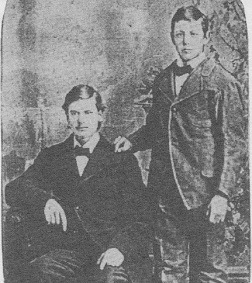| Home |

|
Moses
Younkin |
|
Moses and Lavila
(Mitchell) Younkin |
Moses Younkin was born on May 21, 1830 in Turkeyfoot Township, Somerset County, PA, the son of Henry F. and Mary (King) Younkin.
He was a pioneer of Kansas, a Civil War veteran who knew Buffalo Bill and Wild Bill Cody, and tragically was murdered on the West Coast that led to a racially charged trial.
At the age of 21, on June 5, 1851, Moses married Lavila Mitchell (Aug. 13, 1829-1879), daughter of John A. and Rebecca (Tannehill) Mitchell of Somerset County and grandson of James and Rebecca Mitchell. Rev. John Harned of Harnedsville, Somerset County, officiated.
They produced a family of eight children -- Emma Virginia Younkin, John Mitchell Younkin, Edwin Leander Younkin, Carrie Lycendia Younkin, William Elmer Younkin, Walter B. Younkin, Robert Bruce Younkin and Moses Younkin Jr.
Early in married life, Moses and Lavila made the monumental decision to uproot and move west. They apparently first went to Bloomington, Illinois; and not remaining there long, moved again to Pottowatomie County, KS. Upon learning that his claim there technically was on an Indian reservation, they pulled up stakes and migrated to Clay County, KS.
According to William G. Cutler's book History of the State of Kansas, Moses in 1855 helped to organize the small town of Batcheller (later renamed Milford), Clay County along with local men Abram Barry, S.D. Houston. B.E. Fullington and Frank Smith. In April 1856, when he was age 26 years, along with his brothers Jeremiah and William, and John T. King, settled on Timber Creek in Grant Township, Clay County, KS.
Lavila is acknowledged as the "first white woman in that locality," and their son Edwin Leander Younkin, born in 1858, is considered the "first child of American parentage in Grant township." The Somerset (PA) Herald noted that "During the Kansas trouble [he] was a free soiler and took an active part in defense of Kansas against the Missouri 'border ruffians'."
When the Civil War erupted, Moses resided in Gatesville, KS and was commissioned as a captain of the 15th Kansas State Militia. The regiment later became part of the 11th Kansas Cavalry, Company L. The Whatcom (WA) Daily Reveille newspaper said that during the war, he "acted as a government scout on the plains of Nebraska, Wyoming, Colorado and the Indian territory.... For a number of years he was a companion scout of Buffalo Bill and Wild Bill [Hickok], both of whom he knew intimately."
|
|
|
Moses well-knew Western scouts Buffalo Bill (left) and Wild Bill Hickok |
|
|
|
Lavila's
grave, Timber Creek |
Among the native American tribes in the Clay Center region at that time were the Kaw or Kansas Indians, with bands of Delaware, Wyandotte, Pottawatomie, Sac and Fox passing through on buffalo hunts, picking fights with Pawnee, Sioux, Cheyenne and Arapahoe foes. During those early years of pioneer life, the Younkins and neighbors had to pitch in to help each other in times of need. In one instance, missionary Rev. William Todd and his wagon became sidetracked but "the good-hearted, whole-souled Moses Younkin, who waded the river ... got the log canoe to transport the preacher across. Think of it!" wrote the missionary's nephew, G.W. Southwick. (The Wakefield Colony, 1908, published by the Kansas Historical Society)
Religious meetings were held "every Sunday [in] Mr. Younkin's hospitable house, where Uncle Todd held service." Another time, native Indians killed settlers on the Smoky Hill and began to head toward Timber Creek. Some 18 local men, including Moses and his two brothers, "responded to the call ... well armed for those days, and ready for the fight." But the danger passed when the group learned that in reality it was Pottawatomie warriors who had fought a battle with Pawnees and had been seen celebrating with a war dance. On yet a third occasion, a courier arrived at the Younkin residence with the tragic news that native Indians had attacked a wagon train along the Republican River, with "half of the immigrants killed, and about everything they had destroyed," said a report. "A party went out and buried the dead and brought back the living to Major Barry's place. They were almost starved when found and in a pitiable condition."
In 1864, living in Clay Center, Moses served as a Clay County Commissioner along with John Godwin of Ashland and Charles E. Whitehair of Junction City. Continuing to be interested in the growth and development of his community, in March 1870 he was one of seven charter members of the Wakefield Bridge and Ferry Company. At the time of the battle of the Little Big Horn, at which General Custer and the 7th U.S. Cavalry was wiped out, Moses served in Major Moonlight's Division.
Sadly, Lavila died on March 26, 1879 in Timber Creek near Wakefield, Clay
County.
|
|
|
William with his brothers Moses and Jeremiah and nephew Edwin named in the 1908 booklet, The Wakefield Colony |
After Lavila's death, Moses in 1882 pushed further west into Washington State with others of the Kansas colony and established a ranch in rural Whatcom, Whatcom County. Some of Moses' letters were published in 1997 in the Bulletin of the Whatcom Genealogical Society (Vol. 28, No. 4).
Once settled there, he returned to Wakefield and on Feb. 8, 1883 married Mary Thompson (1848- ? ). He was age 51 at the time, and she 35, a difference in ages of 16 years. The nuptials were performed by Rev. J.L. Dawson at the residence of William Gordon. A friend's account of his return visit to Kansas and marriage was written and sent for reprinting to their hometown newspaper, the Somerset Herald (April 18, 1883), adding "Living where deer, antelope and the red men are scarce, does not seem like home to the Old Frontiersman any more, but to be aroused at any hour of the night by the howling of red men is where Younkin seems to enjoy himself most."
|
| Wakefield Colony booklet |
Suffering from the effects of aging, Moses applied for and was awarded a Civil War pension from the federal government on Oct. 1, 1886. [App. #586.558; Cert. #417.504.] He was a member of the Steadman Post of the Grand Army of the Republic in Bellingham, and of the local Odd Fellows and Ancient Order of United Workmen lodges.
Tragedy befell Moses in January 1892, on a day that he had received his pension check. Two native Indian companions allegedly induced him to walk together along the rail tracks and then attacked him near a little bridge north of Little Squalicum Creek in Bellingham, near the Great Northern Railroad line. He was beaten into incoherence, by a man bearing a club, and was found with his badly cut head in a pool of water near the railroad line. Said the Dalles (OR) Times-Mountaineer, "A physician was sent for and says the man will die before morning. His head looks as though he had been struck several times with ax. The skull is fractured in several places, and the nose is split so that he is a horrible sight." He was carried to the home of John Bennett, where he died. Burial was in the Bayview Cemetery in Bellingham. [Find-a-Grave]
The story was headline news in the Whatcom (WA) Daily Reveille. In a sensational trial -- said by the Los Angeles Herald as "probably the most exciting one ever tried in Whatcom county" -- Lummy Indian George Placid, nicknamed "Old Swiloes" (or "Swiloos") was acquitted after 20 Lummy citizens testified on Swiloes' behalf and established an alibi, although a Skagit Indian boy testified having seen the man strike Moses with a club. "After the verdict was rendered," reported the Herald, "excitement ran high and threats of lynching were heard on every hand. The Indian was quickly taken to the beach, placed in a canoe and started for the reservation under escort of Indians. Within twenty minutes after the verdict was known, a crowd of 1000 people gathered on the street and Mayor Miller of New Whatcom addressed them, denouncing the verdict." Swiloos returned to the court system in October 1907 when charged with drunk and disorderly conduct, with newspapers covering the incident and recalling Moses' murder some years before. Said the Bellingham Herald: "He is a full-blooded Indian and bears all the characteristics of his race.... Many people and old settlers in the county today still fee that the Indian could tell a story of the fate which ended the life of the old soldier when he was waylaid on his way home from the city, supposedly for a jug of whisky."
As a widow, Mary petitioned the federal government for a military pension as compensation for her husband's wartime service. It was awarded on April 23, 1892 [App. #548.759, Cert. #369.455] She also applied to the government for ownership rights to the farmland where they lived in Whatcom County. In 1894, the Commissioner of the General Land Office, as enacted by the Senate and House of Representatives, gave consent "to allow Mary Younkin, widow of Moses Younkin, to enter under the homestead laws, if the said Moses Younkin when living were duly qualified, the north half of the northeast quarter and lots five and six of section sixteen, in township thirty-eight north, of range two east of Willamette meridian, ... lying in Whatcom County ... and to issue patents to [her]." Their great-granddaughter June (Younkin) Steggs was a source for information about this family.
In April 1937, Moses and his parents and siblings were named in a Clay County newspaper article about the inaugural Kansas Younkin Reunion, held at the Wakefield Methodist Church. He also was profiled in the April 30, 1938 edition of the Younkin Family News Bulletin, written by his daughter in law Elisabeth Younkin in British Columbia, saying the Grand Army of the Republic post in Bellingham was named in Moses' honor.
|
Henry and Emma Elias Courtesy Roger and Diana Russell |
~ Daughter Emma Virginia (Younkin) Elias ~
Daughter Emma Virginia Younkin (1852-1933) was born on July 18, 1852 in Bloomington, McLean County, IL. She moved to Clay County, KS in the early 1870s.
In 1875, at the age of 23, she married 28-year-old Henry Alison Elias (1847-1921), a native of Todd, Huntingdon County, PA. Their nuptials were held in Wakefield by the hand of Richard Wake.
They had three children -- Anna Lavila Tannehill, Dr. Francis Elias and Mary Edna Nelson.
In his early years in Wakefield, Henry "reclaimed and developed a valuable farm property," said the 1918 book History of Gage County, Nebraska, authored by Hugh Jackson Dobbs. Shortly before migrating to Kansas, Henry joined the Methodist Church. "His loyalty, his faithfulness and willingness made him a leader in the church life of the community in which he lived," said the Times. "For the last few years of his life he suffered much, but whenever possible he was found in the house of God in the spirit of worship."
Of Henry's movements over the years, the Clay Center Times reported that he:
...grew to manhood in the [Huntington, PA] community in which he was born. He learned well to take his place in the many activities of that early day. In 1868 he came to Kansas, locating in Douglas county, where he remained for two years. He then came to Clay county and settled on Timber Creek, near Wakefield, where he did his part in changing this new territory into a country of homes and school houses and churches.... Not Long after [marriage] they purchased the farm near Wakefield on which they lived for many years. In 1908 they retired from the farm, moving to Manhattan where they have since made their home.
|
Above: barn built of stone by Henry Elias; converted into a private home in the 1980ss. Below: Topeka (KS) Capital-Journal article, 1983 |
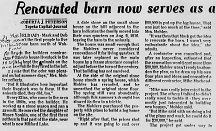 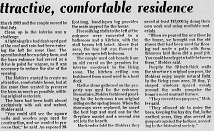 |
|
| L-R: Anna Tannehill, Mary Nelson and Francis Elias. Courtesy Roger and Diana Russell. |
Henry constructed a stone barn on the property in the mid-1870s, with the family initially living in the loft while their animals were on the main floor. He used oak and walnut woods, with square nails and wooden pegs and hand-hewed a 36-foot-long, exposed log to provide the main support for the loft. Walls were 18 inches thick, with small V-shaped windows that not only served as ventilation to keep the hay dry but as gunports should they face an Indian attack. On an adjacent hill, Henry then built a small stone house into which the family took occupancy on Aug. 9, 1876. The date was inscribed on a stone on the house foundation. Next to the house was a spring which still ran abundantly more than a century later. The Eliases remained in that small house until the turn of the 20th century when they erected a larger frame structure. The barn was used to raise dairy cattle, with the doorway functioning as a "drive-in point for wagons," noted the Topeka (KS) Capital-Journal.
In 1880, the U.S. census shows them living as farmers in Grant Township, Clay County, with Emma's unmarried brothers William, Robert and Moses boarding under their roof. Henry was "aligned in the ranks of the Republican party and while residing on his farm in Kansas he was called upon to serve in various local offices of public trust," said the Gage County history. "Both he and his wife are members of the Methodist Episcopal church." They later lived in Riley, Riley County, KS.
Henry died in Riley at the age of 73 on March 26, 1921. An obituary in the Clay Center Times said that funeral services were held in the Methodist Episcopal Church led by Rev. M.S. Collins in Manhattan and Rev. Mitchell in Wakefield.
Emma lived for another dozen years, and was deeply shaken at the accidental death of her married daughter Mary Edna Nelson in a fire. She passed into eternity in Randolph, Riley County at the age of 81 on Aug. 17, 1933. Her remains were returned to Wakefield for entombment. They are mentioned in the 1993 book Philip Mathias of Burnt Cabins, Pennsylvania, authored by Robert Addison Mathias.
In March 1983, some half-century after Emma's death, a couple named Mark and Deb Mohler bought their farm and renovated the barn as their homeplace. The work got underway in March 1983 and after four months they moved in in July 1983. The Capital-Journal ran a story headlined "Renovated Barn Now Serves As Attractive, Comfortable Residence." In describing the history of the barn and how it was built, the article reported that Henry Elias "married the daughter of Moses Yonkin, one of the first three settlers in that part of the state, near what is now Milford Lake."
|
| Younkin Family News Bulletin |
Daughter Anna Lavila Elias (1880- ? ) was born on Nov. 17, 1880 in Wakefield. At the age of 22, on Dec. 3, 1902, she married 29-year-old Rev. Ernest Homer Tannehill (1873-1963), an itinerant Methodist Episcopal minister. They had two children -- Rev. Francis V. Tannehill and Beulah Emily Franke. In 1910, he served a church in Colorado but was transferred that year to the Crab Orchard church in the East District of Nebraska. Circa 1917, he was assigned to the Arma community in the Fort Scott District of Kansas. In 1918 their home was in Centralia, KS. At some point they were in Texas, and by 1937 had relocated back to Wakefield. Around that time, they visited California, trying to find Anna's wayward brother Moses Jr., but failed in the attempt. By December 1939, they had relocated for the winter to Long Beach, CA, living at 1375 East Anaheim Street. A letter from Anna and Ernest was printed in the March 15, 1940 edition of the Younkin Family News Bulletin, saying: "The Christmas season is finding us in 'sunny California,' as you see. We are enjoying California very much, though miss our Texas friends. We have a few friends here and will find new ones, no doubt.... We came into California three weeks ago, and every day has been lovely. You remember we spent the summer in Washington, and we stayed into the rainy season and hence we appreciate the sunshine. Fresh fruits and vegetables are cheap here and so good!" On May 25, 1941, they attended the fifth annual Kansas Younkin Reunion, in Junction City, and Ernest was asked by reunion president Grover C. Younkin to give a short talk. Ernest is believed to have died in Topeka on Dec. 3, 1963, while Anna outlived him by three years and passed on Oct. 28, 1966, also in Topeka. [Find-a-Grave] Ernest is named in the book A History of Methodism in Northwest Kansas, authored by William Henry Sweet.
-
Grandson Rev. Francis V. Tannehill (1907-2000) was born on July 17, 1907 in Hepler, KS. As a boy he moved frequently with his parents as his father was an itinerant Methodist pastor, and graduated from Leroy (KS) High School. He then attended Baker University, graduating in 1930, and obtained a degree in 1932 from Garrett Biblical Institute, today known as Garrett-Evangelical Theological School. On June 11, 1932, at the age of 25, he wed Cecilia Susan Cooper (1906-2008) in Evanston, IL. Their three sons were Robert Cooper Tannehill, Bruce Edward Tannehill and John Ernest Tannehill. As was his father, Francis was a Methodist clergyman, admitted to the pulpit in 1930. His first church was in Wakefield, Clay County, where in April 1937 he preached a sermon at the Kansas Younkin Reunion. He was transferred to Minnesota in 1937 (Preston-Lanesboro and Albert Lea churches); North Dakota in 1949 (including Bismarck, McCabe and Fargo); thence to South Dakota in 1966 (Aberdeen); and back to North Dakota in 1971. While in Bismarck, he was pastor during construction of a new church and parsonage. He retired as Western District Superintendent in 1975. A violinist, he is known to have entertained attendees of the Atchison District meeting of the Woman's Home Missions group in Centralia in 1920. Francis also is believed to have been active in the North Dakota Conference's Commission on Archives and History. Francis died in Bismarck at the age of 93 on Sept. 30, 2000. At the time of his death, their son Robert and his wife Alice lived in Delaware, OH; son John and his wife, Inta resided in Lampeter, PA, and son Bruce and his wife Gail dwelled in Whitefish, MT. As a widow, Cecelia relocated to Ohio to live in a personal care center near her son Robert. She died there at the age of 101 on March 29, 2008.
|
|
| Highland
Cemetery Courtesy Connie Langvard |
Daughter Mary Elias (1887-1922) was born in 1887 on her parents' farm in Wakefield. Said the Clay Center (KS) Times, "She was converted at the age of 10 years and joined the Methodist Episcopal church. She has always been interested in church work and was glad to help wherever she could. She was active in the work of the Y.W.C.A. in college." When a young woman, she attended Grand Island Business College in Nebraska and there met her future husband. On Oct. 6, 1909, she was united in holy matrimony with Jacob Nelson ( ? - ? ) of Bartley, NE. The small ceremony was officiated by Rev. S.A. Bright, with Olive Todd of Clay Center playing Mendelssohn's traditional wedding march. The couple produced four children -- Raymond Nelson, Wilmer Nelson, Eleanor Nelson and Virginia Nelson. Sadly, Virginia died just 13 days after birth in December 1921. Jacob initially was employed with a hardware firm in his home town of Bartley, and the newlyweds first lived there. In the fall of 1917, they relocated to Broughton, KS, joined the Evangelical Church and remained there until 1921. Jacob felt a spiritual calling and entered the ministry of the Evangelical denomination. In March 1922, Jacob accepted his first pastoral assignment in Central Oklahoma at a church in Okarche. Tragedy struck just eight months later in mid-November 1922. While working in the yard of their home in Okarche, Mary's clothes caught fire, and she burned to death. One of her children had the accidental grisly task of discovering the body lying on the ground. She was just 10 days away from celebrating her 35th birthday. Her remains were brought back to Wakefield for burial beside their infant daughter in Highland Cemetery, with the service overseen by Rev. D.F. Honstedt assisted by Rev. Wright, Rev. Dilbeck and Rev. Copeland. Among those who traveled to attend the funeral were her cousins Mrs. Handley of Clay Center, Mrs. Bodine of Morganville and Mrs. Snyder of Broughton. An obituary was printed in her hometown newspapers, the Clay Center Times and the Junction City Daily Union. [Find-a-Grave] Within a few years, on Nov. 11, 1924, Jacob married his second wife, Alice Celesta Burgert (1887-1965), daughter of Samuel A. and Mary E. Burgert of Dundy County, NE. They went on to produce three more children -- Dr. Paul B. Nelson, Esther Watts and Dr. James D. Nelson. Despite his personal devastation, Jacob continued with his ministry work for another 36 years. His church assignments included Mt. Zion, OK (1922-1923), Dennis (1923-1926), Amherst (1926-1931), Worden (1931-1936), Hiawatha (1936-1942), Leonardville (1942-1948) and El Dorado (1948-1951). At Worden, he helped design and construct the new church, and at Leonardsville did drew up plans for a new parsonage. In 1951, he was named an evangelist, serving for three years, and in 1954 was named to pastor a church in Eudora, where he remained until retirement in 1959. In later life, in August 1965, they moved to Newton, KS to be near their son Wilmer. Alice passed away in the Friendly Acres Home in Newton on Dec. 29, 1965 at the age of 78, with an obituary appearing in the Lawrence Daily World. They are mentioned in the book The Golden Year 1883-1933.
-
Grandson Dr. Raymond E. Nelson lived in South Bend, IN in 1965.
-
Grandson Rev. Wilmer H. Nelson (1913-1993) was born on April 11, 1913 in Bartley, NE. He was age nine when his mother died so horrifically. He obtained a bachelor's degree from Kansas University in 1937 and then a divinity degree in 1940 from Evangelical Theological Seminary in Naperville, IL. On May 21,1940, he was wedded to Pauline M. Hefty ( ? - ? ). They had five children -- Roy Nelson, Jean Clark, Linda K. Nelson, Ethel Smith and Nancy Davis. According to the Lawrence Daily World, he was a member of the Kansas United Methodist West Conference and served as a pastor in communities in Kansas and Nebraska, among them Bern, Falls City, Neb., Hillsboro, Florence, Summit and Aulne. During World War II, he held the rank of captain and was an Army chaplain. For 16 years, from 1962 to 1978, he was employed by Friendly Acres Retirement Community in Newton, Harvey County, KS as an administrator. He gave back to the community with membership in the Kiwanis Club in addition to the American Association of Homes for Aging, Kansas Association of Homes for Aging and the board of directors of Friendly Acres Retirement Community. He died on Jan. 9, 1993 and is in repose in the Restland Gardens of Memory Cemetery in Newton. Their daughter Linda K. Nelson (1954-2005) served on the board of trustees of the Salem United Methodist Church and was a member of the Harvey County Committee for Disabled Persons.
-
Granddaughter Eleanor Nelson ( ? - ? ) apparently was deceased by 1965.
|
|
| History of Gage County, NE |
Son Dr. Francis L. Elias (1883- ? ) was born on June 17, 1883 on his parents' farm in Clay County. Upon completing public school education in Wakefield, he entered the University of Kansas medical school and graduated in 1910. He practiced privately for one year in St. George, KS. In 1911, he relocated to Nebraska, where he set up a medical practice in Wymore, Gage County. His "ability and effective service have given him secure place among the representative physicians and surgeons of Gage county," said the 1918 book History of Gage County, Nebraska, authored by Hugh Jackson Dobbs. At age 28, in 1911, he wed Olive Todd ( ? - ? ), a native of Clay County, and they had three children -- Houghton Elias, Winfield Elias and Allison Elias. While in Wymore, he "continued in active general practice as a well fortified physician and surgeon who keeps in full touch with advances made in the profession that has enlisted his earnest and effective services," said the History. "The Doctor has developed a substantial and representative practice and is one of the loyal and progressive citizens of Wymore." After spending four years in Wymore, he took additional education at Johns Hopkins University in Baltimore and then returned to Wymore. Nothing more about him is known.
|
|
|
John and Emma
as pictured in the Younkin |
~ Son John Mitchell Younkin ~
Son John Mitchell Younkin (1856-1932) was born on March 8, 1856 during the family's brief stay in the Pottawattamie reservation in Clay County, KS. He appears to have been named for his mother's father.
At the age of 21 on March 12, 1877, John married 19-year-old Clay County resident Emma Jane Mall (1858-1939), daughter of Philip "Jacob" and Louise (Wehrmann) Mall, formerly of Lucerne, Benton County, IA. Rev. M.E. Wilder officiated in the ceremony at the home of the bride's parents.
They produced seven offspring, four daughters and three sons: Josephine Snyder, Jacob E. "Jack" Younkin, Edwin Younkin, Olive Kathryn Neill, Frances Jackson, Mabel "Belle" Vinzant and Clifford Mall Younkin, and adopted two more, Clara Magnuson and George Younkin.
Early in their marriage, John and Emma relocated to Longford, Clay County. After a period of time there they moved again to Broughton, Clay County. He chose to remain behind in Timber Creek, Clay County, KS in 1882 when his parents left as settlers of Washington State. Ten years later, in January 1892, he learned helplessly the news of his father's tragic beating death in Bellingham, near Seattle.
After their five eldest children married and left home, the Younkins in 1913 moved to Mullen, NE, which was rich in cattle and an opportunity to prosper. They eventually brought two orphans "into their home and taught and cared for them the same as their own." In 1930, having been away in Nebraska for 17 years, John became seriously ill and underwent surgery.
Unable to care for himself on the farm, and never fully recovering, he and Emma returned to Broughton, where they spent their final time on earth. John passed away at age 76 on Aug. 29, 1932. His life story was printed in the Younkin Family News Bulletin (Dec. 20, 1938) as authored by their married daughters Frances Jackson and Olive Neill. Excerpts of this history read as follows:
|
|
| YFNB, Dec. 20, 1938 |
[John's] life's history was much like that of other pioneers who witnessed the barren prairie of Kansas blossom into one of the richest agricultural sections in the West.... We lived on a well improved stock farm in the Broughton neighborhood and it was there we spent the happiest years of our life, while we children were growing up, the many happy memories we have of those days. Father was one of the large cattle feeders of Clay county, but he was never too busy to help a neighbor in time of sickness or trouble. Many times he was called upon, in times of death, to prepare the body for burial, and mother, being a very good nurse, was much in demand when a new baby arrived in the neighborhood, and in cases of serious illness, she would go and sit up night after night caring for the sick, and all this just as a neighborly act, without thought of compensation. Their friends were counted by the hundreds and they were lovingly known as "Dad" and Aunty Younkin. They did not have the opportunity for higher education but were post-graduates in the school of experience. Their wise counsel and advice has smoothed many a rough place in the lives of their children.... [In Nebraska] Father lived a very active life, riding his horse over the ranch looking after the cattle and mother's hospitable home was a favorite stopping place for many people. A hungry rider was always fed no matter what hour of the day.
Emma outlived her husband by seven years. Wrote the daughters, she "made her home with the children. She is past 80 and her hands are never idle although she is crippled with rheumatism. She has pieced numberless quilts and the yards of lovely lace she has knitted and crocheted. her work is very perfect and each child, grandchild and even great-grandchildren hae much prized pieces of her handiwork. She has many old friends who call on her, and while she had a very serious illness last winter, her health is better now, and she is enjoying the summer in Kansas Again. She died in Clay Center, at age 81, on July 29, 1939. They are buried together in Clay Center.
This branch of Younkins is chronicled in the 1954 book Ancestry Mall by Daniel Mall. A descendant, Roger Mall of Clay Center, had some of his distant uncle Moses Younkin's letters and donated copies of the Whatcom Genealogical Society in Bellingham, WA.
|
Ed, Jose and Ollie Younkin |
Daughter Josephine Younkin ( ? -1933) was born in (?). On Nov. 21, 1900, she was united in holy wedlock with John Snyder ( ? - ? ) of Broughton, KS. The ceremony was held at the home of the bride's parents four miles southeast of Broughton, with her brother Jack part of the wedding party. She died in 1933.
Son Edwin Younkin ( ? - ? ) moved to Nebraska as a young man. He served as manager of the Triangle Ranch in Hyannis, NE circa 1938.
Daughter Frances Younkin ( ? - ? ) wed Dr. (?) Jackson ( ? - ? ). They made their home in Clay Center. In 1937 and 1938, she and her sister Olive Neill co-authored histories of their family for the Younkin Family News Bulletin. In the lengthy piece published in the Dec. 20, 1938 edition, which focused primarily on their father, they wrote: "To you of this line or branch, if you will carefully study each and every issue of the Bulletin, you will have a thorough understanding of just where you belong on this great Younkin family tree.... We children feel that we have a priceless heritage in being brought up and taught the simple wholesome way of living by our dear parents."
Daughter Olive Younkin ( ? - ? ) married Clarence Neill ( ? - ? ). Their home in 1938 was Clay Center.
Son Jacob E. "Jack" Younkin ( ? - ? ) took part in his sister Josephine's wedding in November 1900 in Clay Center. In 1905, he was wedded to Nola L. McCormick ( ? - ? ), daughter of George McCormick of Clay Center. A detailed account of their nuptial celebration was printed in the Clay Center Times. Later, he lived in Edinburg, TX, on a citrus farm in the Rio Grande Valley.
Daughter Belle Younkin ( ? - ? ) wed Oran Vinzant (or Venzent) ( ? - ? ). Their residence was in Grand Island, NE in 1938.
Son Clifford Younkin ( ? - ? ) lived on a cattle ranch in Alliance, NE.
Daughter Clara Younkin ( ? - ? ) wed Buster Magnuson ( ? - ? ) and lived in Nebraska.
Son George Younkin ( ? - ? ) resided in Nebraska.
|
|
|
Bird's-eye view of Clay Center, looking north on Fifth Street |
~ Son Edward Leander Younkin ~
Son Edward Leander Younkin (1858- ? ) was born on Dec. 2, 1858 and is considered in Kansas historical circles as the "first child of American parentage in Grant township," Clay County, KS.
As an adult, he migrated west and ended up in Alaska. His final fate is not known, but Younkin genealogy researchers of the 1930s simply noted that he "lived in Alaska."
In April 1938, his sister in law Elisabeth Younkin wrote in the Younkin Family News Bulletin that "the last we hear of Edward, he was in Alaska, and on his way to Siberia."
|
Carrie
Younkin's broken grave |
~ Daughter Carrie Lycendia Younkin ~
Daughter Carrie Lycendia Younkin (1861-1864) was born on May 18, 1861 along Timber Creek in Grant Township, Clay County, KS.
Sadly, she did not survive childhood.
She died on Dec. 8, 1864 at the age of three years and six months. Burial was in Timber Creek.
~ Son William Elmer Younkin ~
|
|
|
1935 letter from William |
Son William Elmer Younkin (1863-1945) was born on Oct. 15, 1863 along Timber Creek, Clay County. Circa 1880, at age 16, he earned a living as a farm laborer and dwelled in the household of his married sister Emma Elias and her husband Henry.
He moved to the Pacific Northwest as a young man. Circa January 1892, he labored in the Similkameen coal mines in British Columbia, Canada. In February 1923, he traveled back to his old home county to visit with family and friends, and thence went to Mullen, NE to see his brother John Mitchell Younkin before returning to Alberta, Canada.
Apparently a bachelor for many years, he married Elisabeth Maxwell ( ? - ? ) when he was 64 years of age, on June 28, 1928. During the summer of 1935, the Younkins received an invitation to attend the Younkin National Home-coming Reunion in the ancient home region of Somerset County, PA. Elisabeth hand-wrote a letter on blue stationery to reunion president Otto Roosevelt Younkin, stating: "Dear Sir: Your kind invitation to your re-union picnic just received, for which we sincerely thank you. As it is impossible for us to join you this year, we send Greeting's to all the members. Trusting you will have a most Enjoyable time. May we hope to hear from you again? Yours most sincerely, William Elmer & Elisabeth Younkin." [View the actual letter.]
In April 1938, a letter from Elisabeth, about her murdered father-in-law, was printed in the Younkin Family News Bulletin. Another of her letters was published later that year, in the Dec. 20, 1938 edition of the YFNB, saying they had moved temporarily to Colfax, CA for medical care: "We left home on the 17th of November and after many tests, X-rays, films, etc., were made, the diagnosis was that his trouble was an infection of the seventh cervical nerve, also arthritis in the cervical vertebrae. He has been given the short wave treatments and electric treatment for the heart. In the comparatively short time he has improved quite a lot, but a complete cure is not promised. However, freedom from pain will be wonderful for him after three long years of it." In the same letter, addressed to YFNB publisher Charles Arthur Younkin in Charleroi, PA, she added:
I think that we have received all our numbers of the Family Bulletin. Will see on my return home and let you know if any are missing. So we are to have relations in faraway Caracas -- the Younkin emblem is certainly far flung! I can appreciate what the reaction would mean to you, after the reunion was over. One can stand a great deal under stress. Perhaps you will have more help from some of the others next year. Do not over-do. You are doing and have done a very unusual and outstanding work which none can fail to appreciate as much as we do.
Then in March 1940, a letter from their niece Anna Lavila (Elias) Tannehill was printed in the YFNB, saying: "Last September we went up into Canada to visit my Uncle Will Younkin and his good wife. We found him in quite bad health. In fact, not able to be up all day. He never complains and is quite cheerful. It is hard to see him suffer so much. I shall inclose a 'snap' of them. It is quite good, we think." At that time, Elisabeth expressed an interest in knowing more about the Younkin coat of arms that had been printed in the YFNB, and how she might obtain a key to the picture. William died in Stewart, Rock Creek, British Columbia at the age of 81 on June 27, 1945. His remains were interred in Rock Creek. Elisabeth's fate is not yet known but will be added here when learned.
|
William and Walter Younkin |
~ Son Walter B. Younkin ~
Son Walter B. Younkin (1866- ? ) was born on July 29, 1866 along Timber Creek in Grant Township, Clay County.
He did not stay in touch with his adult siblings, and in April 1938, writing in the Younkin Family News Bulletin, his brother William's wife said "Walter has been lost sight of."
He is believed to have lived in San Francisco and to have died in Bellingham, Whatcom County, WA. Nothing more is known.
~ Son Robert Bruce Younkin ~
Son Robert Bruce Younkin (1869-1941) was born on Jan. 19, 1869 along Timber Creek in Grant Township, Clay County.
In 1882, when he was 13 years of age, he chose to stay in Timber Creek when his parents moved to Washington State.
He was raised by his married sister and brother in law, Emma and Henry Elias.
Robert married Kansas native Mabel Weir (1885- ? ) on Oct. 2, 1901, when he was age 32.
He died on Sept. 2, 1941, at age 72.
~ Son Moses Younkin Jr. ~
Son Moses Younkin Jr. (1871- ? ) was born on June 20, 1871 along Timber Creek in Grant Township, Clay County.
When the federal census was taken in 1880, he and two of his brothers made their home with married sister and brother in law, Emma and Henry Elias in Grant Township. He resided in Seattle in 1892 at the age of 21.
Upon hearing of the brutal attack upon his father in Bellingham in January 1892, he hurried to the scene via the Premier rail service and is believed to have been at the deathbed.
He apparently lived in San Francisco at some point in time. In April 1938, his sister in law Elisabeth Younkin wrote in the Younkin Family News Bulletin that "we heard Moses was in California." He is reputed to have died in Bellingham, Whatcom County, WA and to be buried in Oakland, CA.
Copyright © 2014-2016, 2018 Mark A. Miner |
Research for this page graciously shared by Roger and Diana Russell, Joan Caldwell,the late Donna (Younkin) Logan, Marian (Smith) Posey, Laurel Posey, Loretta (Adams) Kelldorf, Blair E. "Junior" Younkin Jr., Kay Lynn Younkin and the Historical and Genealogical Society of Somerset County. |
